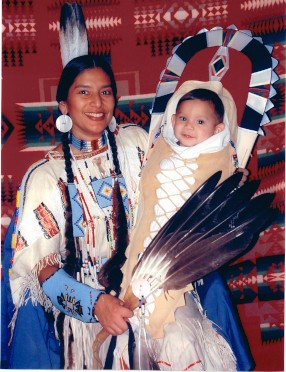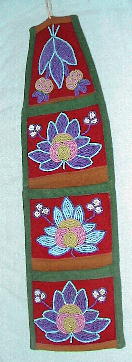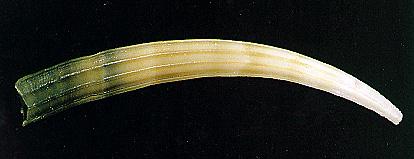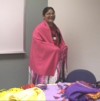|
A Lewis and Clark PerspectiveOn September 20th 1805, William Clark wrote:
. . . They call themselves Cho pun-nish or Pirced Noses; their dialect appears verry different from of the (flat heads) Tushapaws altho origneally the Same people They are darker than the (Flat heads) Tushapaws (I have seen)
Their dress Similar, with more beads white & blue principally, brass & Copper in different forms, Shells and ware their haire in the same way. they are large Portly men Small women & handsom fetued.
And Clark continued on October 10th 1805: . . . the Cho-pun-nish or Pierced mose Indians are Stout likely men, handsom women, and verry dressy in their way, the dress of the men are a white Buffalow robe or Elk Skin dressed with Beeds which are generally white, Sea Shells?ie the Mother of Pirl hung to ther hair & on a pice of otter Skin about their necks
hair Cewed in two parsels hanging forward over their Sholders, feathers, and different Coloured Paints which they find in their Countrey Generally white, Green & light Blue. Some fiew wear a Shirt of Dressed Skins and long legins, & Mockersons Painted, which appears to be their winters dress, with a plat of twisted grass about their necks.
The women dress in a shirt of Ibex, or (Goat) [X: Argalia] Skins which reach quite down to their anckles with (out) a girdle; their heads are not ornamented, their Shirts are ornamented with quilled Brass, Small peces of Brass Cut into different forms, Beeds, Shells and curios bones &c. The men expose those parts which are generally kept from few [X: view] by other nations but the women are more particular than any other nation which I have passed in Screting the parts. . . .

|
Angel and Payton Sobotta in Regalia - during a November 2001 Powwow.
|
|
|
| |
Josiah Pinkham discusses the importance of song and art. (Interviewed by Rodney Frey, March 2002) |
| |
Nakia Williamson talks about the gift of a special beaded vest. (Interviewed by Ann McCormack February 2002) |
The Nimíipuu have always appreciated great beauty and take great care in every detail of their appearance and cleanliness. Not only was traditional clothing and ornamentation meant to be pleasing for both the wearer and observer, but it also symbolized an expression of ones power, rank, or other indication of individual identity.

|
Beaded Wall Pocket belonging to Mylie Lawyer. click on for enlarged image of beaded detail.
|
|
Josiah Pinkham discusses trade cloth and otter braid wraps. (Interviewed by Rodney Frey, March 2002) |
In the past and continuing today as seen in dance regalia, clothing was made from the dressed hides of various animals, particularly deer, elk, bison, bear, and coyote. What was worn depended upon the season, materials available, and the activity of the wearer. Common clothing included buckskin shirts and leggings often with fringes, breechclouts, mittens, robes, and moccasins. Women often wore long skirts, dresses, and aprons. For special occasions, clothing was decorated with various types of beads, shells, elk teeth, feathers, animal skins, porcupine quills, and other ornaments. Although this practice is not confirmed by oral tradition, Lewis and Clark and other early explorers noted that some Nimíipuu wore a decorative dentalium shell through the pierced septum of their nose; thus the French-Canadian bestowal of the name, "Nez Perce" or Pierced Noses.

|
Dentalium Shell. Photo courtesy the Nez Perce National Historical Park (enlarged: actual length about 7 millimeters)
|
Nimíipuu women wore basket hats (fez-shaped) made from twined, grasses and hemp cordage. Feather bonnets were also seen among men, and remain a vital part of powwow dance regalia. Both sexes painted their faces with paints made from various minerals or organic matter mixed with oil. The painting of the face as well as other body parts helped to protect them from the sun, poor weather, and insects. It also acted as a way to communicate mood, intent, attraction, spiritual purpose, or other form of communication.
| |
Mylie Lawyer talks about her grandfather's, Chief Lawyer's, pipe bag. (Interviewed by Ann McCormack and Josiah Pinkham, February 2002) |
| |
Listen as Beatrice Miles, tribal elder, talks about the men's traditional hairstyle. (Interviewed by Josiah Pinkham) |
|
|
Lynn Pinkham discusses the making of shawls for powwow dancing and her use of flat fringe. (Interviewed by Ann McCormack, March 2002) |
View some examples of traditional women's clothing:
- Angel Sobotta on War Pony Spirit - both in regalia
- Angel Sobotta in dance regalia, while with the Ben Marrah Dance Company
- Woman's Dress, with beaded design
-
Woman's Dress, with elk tooth design
- Woman's Dress, beaded with cowrie shells
- Women's Basket Hat
© Nez Perce Tribe 2002
< previous |
next > |
|
|















